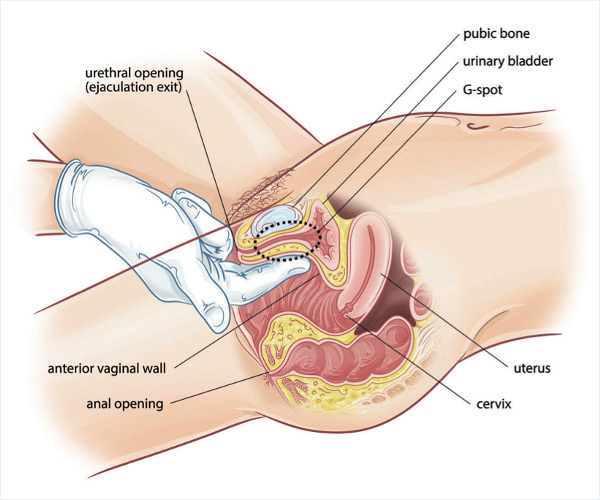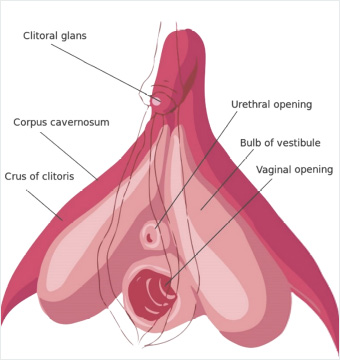
The G spot has been one of the most discussed topics within the scope of female sexuality especially in recent years. “Does a G spot exist? Where is the G spot located? How can it be located? Does it exist in every woman? How is the G spot stimulated?” Questions like these are in the minds of many people. The G-spot and Clitoris believed to create a miraculous orgasm in women have been at the center of sexual research for years.
The G spot also known as “G zone” was described first by the German gynecologist Grafenberg in 1950. According to Grafenberg, this spot is the most erogenous area of the vagina, i.e., the easiest-to-stimulate zone that gives the strongest sexual pleasure when stimulated. For years, this zone has been called the "Grafenberg spot" referring to the name of the physician who has defined it for the first time. Over time, the name has been abbreviated as the ‘G spot’.
Undoubtedly, people have been most curious about the answer to the question ‘where is the G spot located?’ While the existence of the G-spot is controversial, there is no consensus yet on its location. It is claimed to be between the vaginal opening and the urethral orifice, on the anterior vaginal wall, 2-3 cm inside of vaginal entrance. The figure below shows the location of the G spot inside the vagina.

To find the G spot; the anterior vaginal wall can be gently pressed by making a “come hither” motion using the index finger. It is said that the area where the G spot is located is felt as a lumpy spot during this motion. In addition, massaging this area with the finger increases the blood flow there, and an enlargement is felt with the finger to a considerable extent. It is normal for the woman to slightly feel like she needs to urinate.
Stimulation of the G-spot with a vibrator or by vibrating the finger is also known as “G-spot massage” which can cause female ejaculation. Female ejaculation occurs more obviously in some women.
However, the G spot does not have a standard location that is the same in every woman. For this reason, many studies have been carried out to find its location. Since there is no objective method to use, researchers have focused on two purposes. These are;
Both of these depend on the individual and this decreases the reliability of the studies. For example, a 1983 study examined the G-regions of 11 women. The entire vaginal surface was stimulated by touch, and 4 of 11 women were found to have a more sensitive area in the anterior vaginal wall. This area is thought to be the G spot.
In some cadaveric studies, researchers claimed that they have identified this region anatomically. However, its existence has yet to be proven histologically (by tissue science). Therefore, we can say that G-spot is an erogenous, sensitive, functional area, different from an anatomical organ.
In the past, the fluid secreted in the condition called female ejaculation or lubrication was thought to be very valuable. Vaginal stimulation was provided by various methods to obtain this fluid that was used in the treatment of many diseases. In this way, "female ejaculation" was defined for the first time in the 17th century.
In the following years, a spot or zone in the vagina, which provides female ejaculation, has been the subject of research. It was initially argued that the anterior vaginal wall the entire canal might be more sensitive, but the presence of an erogenous spot was shown in the following years. The gynecologist Dr. Grafenberg was the first to define this spot, and this erogenous zone he defined became more popular after his death and began to be called ‘the G-spot’, referring to his name.
Vaginal squirting is a condition characterized by the gushing-like ejaculation of a woman during sexual intercourse or masturbation. “Squirting” occurs only in some women. The fluid that comes out is thought to originate from the skene glands equivalent to the prostate gland.
✓ There is a belief that stimulation of the G spot is the basis of vaginal orgasm. Vaginal orgasm is defined as an orgasm that occurs without external clitoral stimulation while the penis is in the vagina. It is claimed that the stimulation of the G-spot causes strong sexual arousal and “coital orgasm” i.e. vaginal orgasm. The idea that the stimulation of the clitoris causes clitoral orgasm and the stimulation of the G spot causes vaginal orgasm is not widely accepted today.
✓ Another claim about the G spot is that it causes “female ejaculation” (squirting) when stimulated. In female ejaculation, different from orgasm, fluid comes out of the secretory canals during sexual intercourse, similar to the ejaculation in men. Expulsion of fluid (ejaculation) during sexual intercourse in women is a rare situation, and it has no effect on whether or not the woman achieves orgasm.
✓ 2001, the G Spot Anatomical Terminology Committee announced that the Skene glands surrounding the female urinary tract are “female prostates.” In other words, the female counterpart of the prostate in the men is the Skene glands. The location of these glands corresponds to the location of the G-spot. Female ejaculation is thought to be created by the fluid that comes out of this gland as a result of the stimulation of the G spot. For this reason, researchers claim that the G spot is another system of glands and ducts. However, its existence has yet to be scientifically proven.
✓ There are many surgical and non-surgical procedures (G shot, O shot, etc.) performed on this area to increase sexual pleasure.
Stimulation of the G spot can be achieved manually or through sexual intercourse with the penis. Its stimulation is usually difficult with the classic missionary position (man-on-top position) during sexual intercourse. Sex positions that increase the pressure on the anterior vaginal wall facilitate arousal. Thus, the “doggy position” would be more suitable.
Sometimes, women also use dildos or vibrators to discover their G-spot. In this way, a woman who discovers the location of her G spot can more easily guide her partner during sexual intercourse.
Although stimulation of the G-spot is not necessary to achieve orgasm, some women emphasize that stimulation of this point is more satisfactory. However, many women also need direct clitoral stimulation to achieve orgasm. This does not indicate a problem or insufficiency in the relationship. It does not matter by which method the orgasm is achieved.
The G-spot augmentation procedure is known as G Shot. G shot injection is performed;
The area on the anterior vaginal wall, which is considered to be the G spot, is augmented by filler (hyaluronic acid or adipose tissue) injection. This procedure is thought to facilitate the stimulation of the G-spot. However, the safety and effectiveness of the treatment has yet to be proven. It has been emphasized that sexual dysfunction, infection, dyspareunia (painful sexual intercourse) and poor wound healing may be encountered after the procedure. Therefore, over time, the G shot has been replaced by the O Shot procedure, also known as the “orgasm shot”.
O Shot, also known as the orgasm shot, is the procedure that involves the injection of PRP (Platelet Rich Plasma) to the clitoris circumference and the G spot with a special technique. PRP is the plasma part of the person’s own blood, which is prepared by a special centrifugation process. It contains growth factors. PRP renews the cells and increases blood supply in the area where it is applied. After the O Shot application, women were observed to experience vaginal stimulation more easily and reach orgasm more quickly during sexual intercourse. Our patients who consider G Shot (G spot augmentation) and O Shot (orgasm shot) can make an appointment at our clinic.

Recent studies have revealed an anatomical relationship between the clitoris and the G spot. The clitoris consists of three sections: the glans (head),corpus and crura (legs). In clitoris, the glans is the only section visible when viewed from the outside. Other sections are closely adjacent to the anterior vaginal wall and are closely related to the G spot. The figure above shows the anatomy of the clitoris.
Another issue that has yet to be clarified is whether the stimulated area triggering the vaginal orgasm is the G spot or the crusts of the clitoris. The opinion adopted in recent years is that the clitoris is stimulated by a sensitive area on the anterior vaginal wall rather than a spot in the vagina. This area has recently been called the “clitoral-urethral-vaginal complex” or simply the “clitoral complex”.
Although clitoral and vaginal orgasms have been defined as different types of orgasm for years, recent research has revealed that all types of orgasms are actually associated with the clitoris. There are three types of orgasms in women:
Clitoral orgasm: It is triggered by stimulating the clitoral glans (external, visible part of the clitoris) directly by hand, mouth or friction during sexual intercourse. It is described as a shorter, explosive orgasm.
Coital orgasm: It is a type of orgasm formerly known as “vaginal orgasm”. It occurs as a result of the stimulation of the clitoral complex with a penis during sexual intercourse (coitus),or with the use of finger or a device such as a dildo-vibrator. Although it is not explosive like clitoral orgasm, it is said to last longer and provide more satisfaction.
It is stated that female ejaculation can occur during coital orgasm. However, female ejaculation rarely occurs. It is known that it is not necessary for achieving orgasm and there is no data showing that it increases pleasure during orgasm.
Mixed orgasm: It is a type of orgasm, which occurs as a result of the stimulation of both the inside of the vagina and the outside part of the clitoris simultaneously. In a 1990s study, women's brain waves and blood flows were measured during each of the three types of orgasm, and then based on these measurements, it was ascertained that the strongest orgasm was not vaginal (coital) orgasm as thought, but “mixed orgasm”.
Usually, it occurs with manual stimulation of the outside part of the clitoris by the woman or her partner while the penis is in her vagina during sexual intercourse. It is one of the most recommended methods for women to achieve orgasm during sexual intercourse. In fact, it doesn't matter with what method orgasm happens, because orgasm is a natural result rather than not a goal. A relaxed mind and body can easily experience orgasm.
The greatest debate about the G-spot is whether such a point really exists! Studies conducted with monozygotic twins, who are known to have the same genes, produced confusing findings regarding the existence of the G spot. There are studies reporting the existence of a G spot in one of the twins while reporting non-existence in the other. The results of these studies conducted on identical twins known to be genetically identical have raised serious doubts about the existence of the G-spot.
Inadequacies of the studies showing the existence of the G-spot: Many researchers have investigated the existence of the G spot, but most of such studies have been conducted with a small number of patients. In addition, the existence of such an area as an anatomical organ has yet to be proven. The outer 1/3 portion of the vagina is already known to be more sensitive because it has more neural networks. However, it has not been scientifically proven that a certain point in the vagina has higher neural density.
Clitoris-G spot relationship: The clitoris is the biggest erogenous organ in women. Many studies in recent years have defined the area called the G-spot as a “clitoral-vaginal complex” that actually includes the anterior vaginal wall and part of the urethra; while on the other hand, some researchers argue that the G spot is a separate erectile tissue. This issue has not yet been fully clarified.
Attributing an exaggerated meaning to the G-point: Women have always been curious about the popular topic of the G-spot. The G-spot described as a miraculous spot has begun to be known as a magical spot that provides a miraculous orgasm when stimulated.
Many women started looking for a G spot in their body and began to feel seriously anxious about this issue. The feeling of “deficiency and inadequacy” has developed in women who thought they were deprived of a G spot. This may lead to lack of sexual pleasure and lack of sexual drive in the course of time.
When the pleasure of sexual intercourse is prioritized, and when stimulating the G spot with the penis to experience a vaginal (coital) orgasm is the only aim, it becomes inevitable to experience orgasm problems after a while. Therefore, it would be most appropriate to stop trying to ascertain whether a G-spot exist, and to let the mind and body have pleasure from the sexual intercourse. It should also be kept in mind that there are many methods such as the O-shot procedure intended to increase sexual pleasure and facilitate orgasm.